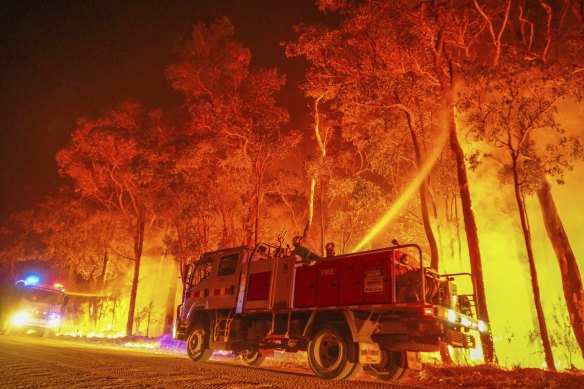A rally will be held in Margaret River at the weekend to call on the state government to fund rapid bushfire suppression equipment and scale back “failing” prescribed burns in the South West.
Globally there has been a shift towards adopting new early detection and rapid suppression equipment to quickly identify and extinguish bushfires.

A rally will be held in Margaret River to call on the state government to challenge its thinking on fighting fires.Credit: Sean Blocksidge
The technology, including smoke detection cameras, satellite monitoring, AI software and drones to give a bird’s-eye view to spot developing fires, is already operational in Canada and California.
It is being rolled out in European countries and along the east coast of Australia.
WA Forest Alliance senior campaigner Jason Fowler said the WA government and Department of Biodiversity, Conservation and Attractions were lagging and reliant on “outdated and dangerous” policy.
“The prescribed burning program is no longer effective at protecting South West communities in a drying and warming climate,” he said.
“Only half of prescribed burns close to communities have been completed last year because they are too risky.
“Forests are also suffering with an increasing number of high-intensity burns causing severe damage.”
Fire behaviour scientist Philip Zylstra said research by the CSIRO and DBCA showed that forest understoreys were the primary driver of fire risk, and that burning forests caused a “pulse” of dense understorey growth.
“We published an independent examination of DBCA records in a leading international journal showing that bushfires follow this same trend,” he said.
“After a couple of years, prescribed burning has made bushfire far more likely for decades to follow.
“The evidence is now more solid than it has ever been in WA history. The long-unburnt forests are a priceless advantage for reducing bushfire risk and they must be protected”.
Zoologist Phil Runham supported calls to move away from prescribed burning to rapid suppression as he witnessed sustained impacts to wildlife.
He said current fire regimes were one of the primary dangers to the increasing list of threatened species, which could take more than 30 years to recover following burning.
“Prescribed burning every 6-10 years amplifies the direct impact of feral predators such as foxes and cats on our native fauna,” he said.
“It destroys habitats and kills many animals, leaving surviving native animals without shelter and food for extended periods.”
A petition is before state parliament that calls for the funding of new early detection and rapid suppression technology.
It also calls for a moratorium on burning long unburnt, fire-intolerant and fire-sensitive species and ecological communities, such as peats, granites, wandoo and tingles, until a management policy is developed.
Finally, it calls for the state to abandon the current prescribed burning policy of igniting 200,000 hectares per year in the South West.
Greens MP Brad Pettitt said forests were already stressed as a result of the driest summer on record, and WA’s current prescribed burning policy in its current form was only worsening this.
It is time for an independent scientific review, as requested by the community, local environmental scientists and even the EPA, and a fresh approach to fire management that better protects our unique ecosystems,” he said.
In 2023–24 more than 100,000 hectares of prescribed burning was undertaken in the South West, while nearly six million hectares were burnt around the state.
A department spokesman agreed quick detection and direct on-ground suppression efforts were critical in minimising the size and impact of bushfires as well as prescribed burning to reduce fuel loads.
“DBCA’s early bushfire detection network includes the aerial spotter fleet of 10 American Champion Scout aircraft. The fleet operates out of four main bases across the South West, Jandakot, Bunbury, Manjimup and Albany – providing critical information to fire controllers from about 350 bushfires each year,” he said.
“The aerial detection fleet is supported by 13 fire lookout towers and satellite technology used to detect and monitor fires in the early bushfire detection network.”
The spokesman said the department continued to explore new and emerging technology that may assist with early bushfire detection and enhance bushfire response arrangements.
Environment Minister Reece Whitby was contacted for comment.
Opposition emergency services spokesman Martin Aldridge said while we couldn’t underestimate the effectiveness of prescribed burns, in the face of more extreme weather conditions and fuel dryness, it was essential to adopt a variety of strategies to mitigate the risks of fire.
“Technology and innovation have a huge role to play in early detection and rapid fire suppression but WA is lagging behind,” he said.
“NSW, Queensland and South Australia have all implemented smart fire detection technology which involves cameras equipped with artificial intelligence technology to detect smoke in forest areas.”
The rally will be held at 11am on Saturday, September 14 at the Memorial Park in Margaret River.
Start the day with a summary of the day’s most important and interesting stories, analysis and insights. Sign up for our Morning Edition newsletter.